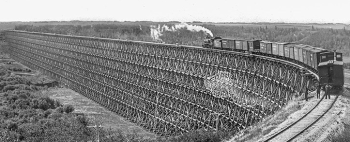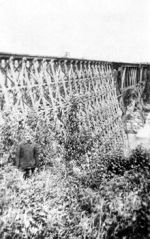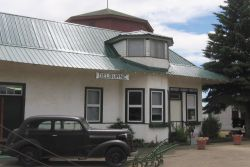|
Grand Trunk Pacific Railway in Central Alberta
built 1911-12
(Three Hills subdivision of Canadian National Railway 1920-present)
Revised May 2022
Photo descriptions
and credits at bottom of page.
Construction began on the Grand Trunk Pacific
Railway, a subsidiary of the Grand Trunk Railway, in Western Canada
in 1905 as transcontinental competition for the Canadian Pacific
Railway. The line was built from Fort William, Ontario (now Thunder
Bay) through to Winnipeg, Saskatoon, Edmonton, and eventually on to
Prince Rupert, B.C. The railway reached Edmonton in 1909 and
continued the following year to Jasper.
In late 1909 construction started on a branch line at Tofield that
was to head south towards Calgary, roughly parallel to and east of
the Calgary and Edmonton Railway. Much of the route was the same as
that surveyed by the Alberta and Athabasca Railway Company in the
late 1880s as the original proposed route linking Calgary with
Edmonton. Construction was fairly rapid reaching Camrose in early
1910.

The next challenge was to get across the Battle River.
The
Duhamel wooden trestle bridge was completed in 1910 over the Battle
River 20 km southwest of Camrose. At almost 4,000 ft. long and 120
ft. high, it was the longest and one of the largest wooden bridges
ever built in the world.
The next step was to determine a location for a future divisional
point where crews would change and rail facilities built.

The
railway tried to purchase land at Lamerton, a small town on a
north-south native and fur-trade trail approximately half way
between Edmonton and Calgary. A proposed deal with the landowner
fell through so the railway created a new town 2 km south instead
and called it Mirror late in 1910. A roundhouse, rail yards and
other facilities were constructed.
As Mirror grew to a town of 1,000 people with stores, banks and
other amenities, including a plan to build a lakeside resort nearby,
Lamerton quickly died. The first passenger train arrived in Mirror
in July 1911.

The following year, the line continued south through Alix, Ardley
and Delburne to Trochu and Three Hills. Another hurdle on that
section of line was the Red Deer River. A wooden trestle bridge
1,500 ft. long and 158' tall was
built in 1911 just north of Ardley but it was destroyed by river
flooding a few years later. The centre portion of the bridge was immediately replaced by
three
steel spans with two steel towers. Ardley had some
significance at the time as a coal-mining community.
The line continued south through Beiseker, Irricana and reached
Calgary in 1914.
In 1920, the Grand Trunk Pacific became part of Canadian National
Railways.
With the consolidation of the Grand Trunk Pacific and the Canadian
Northern which both had parallel north-south routes between Edmonton
and Calgary east of the Canadian Pacific, two significant changes
occurred.

In
1923, Mirror became even more significant as a divisional point with
the elimination of Big Valley as a divisional point on the Canadian
Northern line.
Mirror also became the connection point to the Brazeau subdivision
to Red Deer, Rocky Mountain House and Nordegg of the former Canadian
Northern Western Railway. The previous connection with the Canadian
Northern farther east was removed.
Another major change was the dismantling in 1924 of the Duhamel
wooden trestle when Canadian National Railways decided to use the
Canadian Northern crossing of the Battle River further east. A new
connection was built on the south side of the river.

The Ardley bridge washed out in 1952. It was replaced by a steel
trestle and reopened in 1955.
Passenger service between Edmonton and Calgary continued on
both lines south of Camrose. Steam was replaced by Railiner service
in the mid-1950s. The last Railiners were used in the 1970s.
Although the former Grand Trunk Pacific line is still used as the
primary Canadian National link between Edmonton and Calgary, much of
the former infrastructure is gone.

Mirror lost a lot of its
significance as a railway town when diesel replaced steam in the
1950s. It lost even more significance when the railroad ran through
trains between the two largest Alberta centres without changing
crews at Mirror. Once a thriving town, Mirror is now a small hamlet
in Lacombe County.
 The Ardley station was closed in 1965 and sold to a farmer close to
the community for $30 for use as a farm building two years later. The stations at Bashaw,
Alix, Lousana, Elnora, Huxley, Trochu and most others along the line
were dismantled or sold. The Ardley station was closed in 1965 and sold to a farmer close to
the community for $30 for use as a farm building two years later. The stations at Bashaw,
Alix, Lousana, Elnora, Huxley, Trochu and most others along the line
were dismantled or sold.

The
Delburne station was moved to a new location to become the
Anthony Henday Musuem which includes a caboose and wooden water
tower.
In Three Hills, the station was relocated and turned into the
Kneehills Historic Museum which includes a caboose and box car.
Railway Bridges of Central Alberta
Railway Stations of Central Alberta
Photo descriptions and credits:
Header:
Delburne 1912 GTP station, water
tower, caboose at Anthony Henday Museum (Paul
Pettypiece 2007);
Duhamel GTP timber trestle near Camrose ca 1912 (Provincial Archives
of Alberta - Bamber);
Mirror Grand Trunk Pacific roundhouse and yard 1912 (source
unknown);
Ardley GTP timber bridge over Red Deer River 1916 (Red Deer
Archives, Prov. Archives of Alberta 82-26-1);
Mirror Grand Trunk Pacific roundhouse, yard and station 1928 (source
unknown);
Ardley CNR/GTP bridge washout 1952 (Red Deer Archives P7378, Prov.
Archives of Alberta 79-20-25);
Ardley CNR bridge over Red Deer River north of Delburne (Paul
Pettypiece 2011);
Ardley 1911 Grand Trunk Pacific type E station now farm building (Paul Pettypiece
2010);
Delburne 1912 Grand Trunk Pacific type E station at Anthony Henday Museum (Paul
Pettypiece 2007);
|

